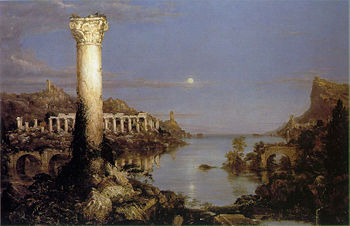About Thomas Cole's The Course of Empire
There is the moral of all human tales;
'Tis but the same rehearsal of the past.
First freedom and then Glory - when that fails,
Wealth, vice, corruption - barbarism at last.
And History, with all her volumes vast,
Hath but one page...
-Lord Byron, Childe Harold's Pilgrimage (1812-1818)
Thomas Cole's The Course of Empire (1834-36) is a series of five allegorical paintings depicting the rise and fall of a fantastical civilization. Cole envisions a prehistoric age in which nature dominates man (The Savage State); an ancient utopia in which people live in balance with nature (The Pastoral State); an era of decadence (Consummation); war and chaos (Destruction); and finally, an uninhabited world in which the ruins of mankind are once again overtaken by nature (Desolation).
Scroll down to explore the contexts behind Cole's artistry and narrative, then examine each of the five paintings in detail.
The Landscape
Thomas Cole is considered one of the first great American landscape painters, and these five paintings are a virtuosic display. His work was inextricably influenced by the Romantic ideal of the Sublime wilderness, and influences from European art.
Landscape and its artistic representation was deeply important for America's national identity in the 19th century, and the fate of the wilderness had spiritual and political resonance for Cole and like-minded artists and intellectuals.
The Story
The five paintings are set at the same site during progressive times of day, each with different moods and weather conditions (the first painting depicts a tumultous cloudscape at dawn; the final painting is tranquil twilight). Cole imbues each view of this landscape with its own emotional state.
Cole's imaginary civilization looks and acts like an ancient Greek or Roman society, from the wise philosopher sketching geometric diagrams in the dirt in The Pastoral State to the monumental statue of a discus-throwing Gladiator in Destruction.
The Allegory
Empire depicts the complete life cycle of a civilization. In this, Cole was influenced by cyclical theories of history well known to intellectuals in Cole's time, as well as global and national current events.
The generic Classical setting of Cole's story lends it a sense of timelessness. The paintings are a universal parable that can be applied to any civilization, and it was seen in the light of current events and trends in Cole's own time. It can be understood just as easily today.




 VIDEO: The Hudson River Valley
VIDEO: The Hudson River Valley  VIDEO: Precedents in European Painting
VIDEO: Precedents in European Painting  VIDEO: The Establishment of an American Landscape
VIDEO: The Establishment of an American Landscape  VIDEO: Telling a Story Through Landscape
VIDEO: Telling a Story Through Landscape  VIDEO: Greco-Roman Vocabulary
VIDEO: Greco-Roman Vocabulary  VIDEO: An Allegory of Empire
VIDEO: An Allegory of Empire  VIDEO: A Universal Parable
VIDEO: A Universal Parable  The Savage State (1834)
The Savage State (1834) The Pastoral State (1834)
The Pastoral State (1834) Consummation (1836)
Consummation (1836) Destruction (1836)
Destruction (1836) Desolation (1836)
Desolation (1836)